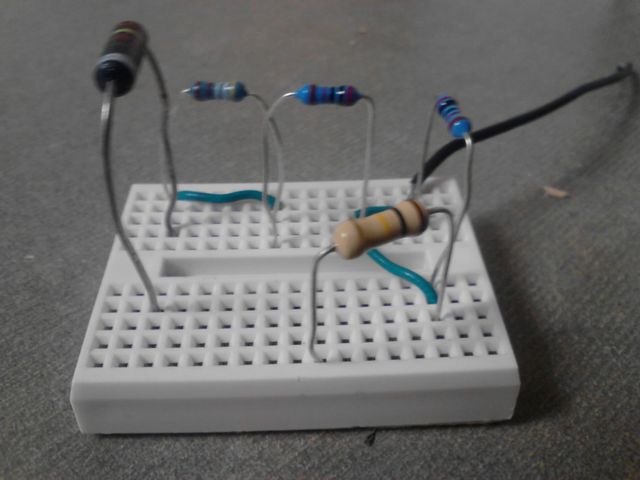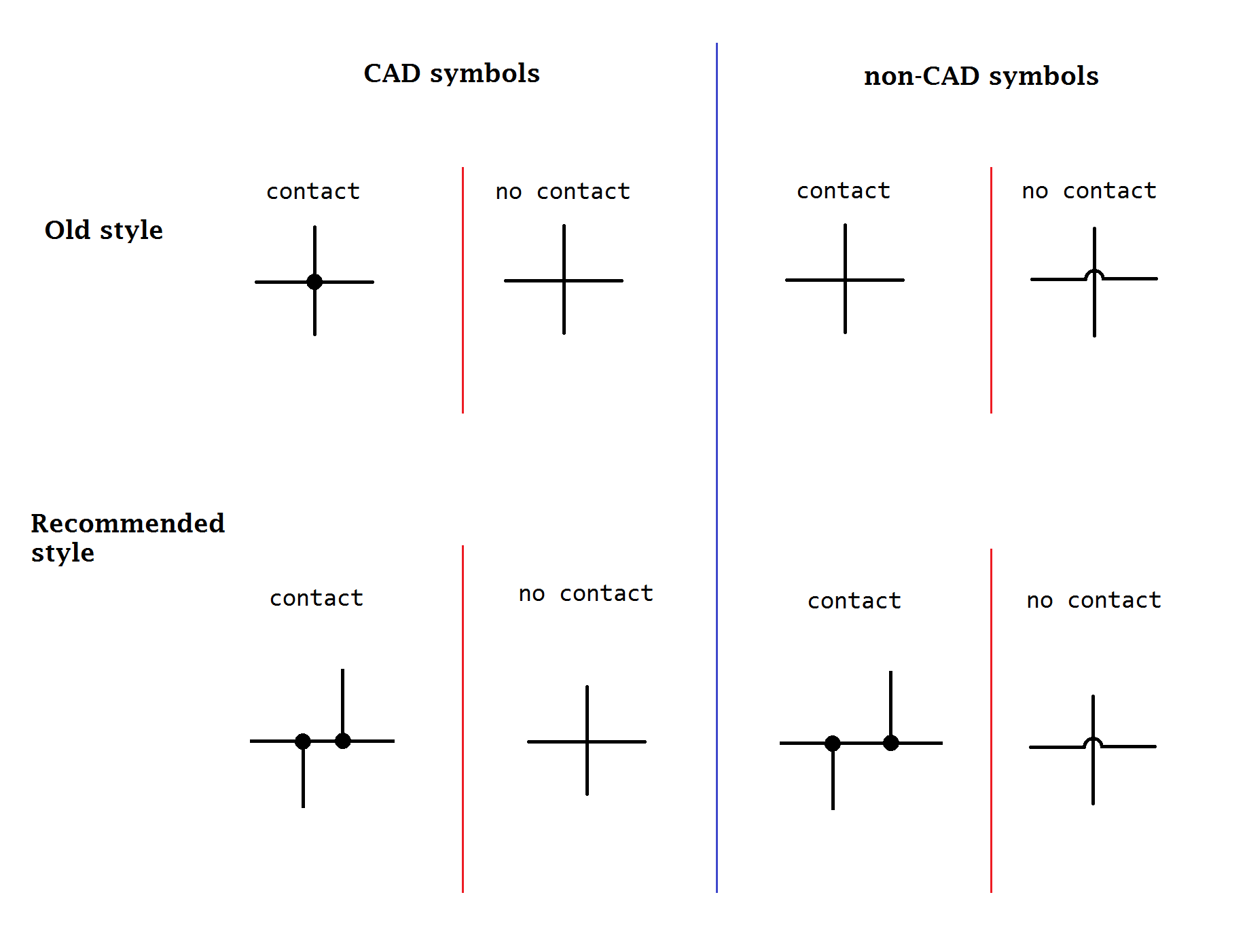|
Perfboard
Perfboard is a material for prototyping electronic circuits. It is a thin, rigid sheet with holes pre-drilled at standard intervals across a grid, usually a square grid of spacing. These holes are ringed by round or square copper pads, though bare boards are also available. Inexpensive perfboard may have pads on only one side of the board, while better quality perfboard can have pads on both sides ( plate-through holes). Since each pad is electrically isolated, the builder makes all connections with either wire wrap or miniature point to point wiring techniques. Discrete components are soldered to the prototype board such as resistors, capacitors, and integrated circuits. The substrate is typically made of paper laminated with phenolic resin (such as FR-2) or a fiberglass-reinforced epoxy laminate (FR-4). Connections The grid system accommodates integrated circuits in DIP packages and many other types of through-hole components. Perfboard is not designed for prototyping ... [...More Info...] [...Related Items...] OR: [Wikipedia] [Google] [Baidu] |
Electronic Prototype
In electronics, prototyping means building an actual circuit to a theoretical design to verify that it works, and to provide a physical platform for debugging it if it does not. The prototype is often constructed using techniques such as wire wrapping or using a breadboard, stripboard or perfboard, with the result being a circuit that is electrically identical to the design but not physically identical to the final product. Open-source tools like Fritzing exist to document electronic prototypes (especially the breadboard-based ones) and move toward physical production. Prototyping platforms such as Arduino also simplify the task of programming and interacting with a microcontroller. The developer can choose to deploy their invention as-is using the prototyping platform, or replace it with only the microcontroller chip and the circuitry that is relevant to their product. A technician can quickly build a prototype (and make additions and modifications) using these techniques, but f ... [...More Info...] [...Related Items...] OR: [Wikipedia] [Google] [Baidu] |
Veroboard
Stripboard is the generic name for a widely used type of electronics prototyping material for circuit boards characterized by a pre-formed regular (rectangular) grid of holes, with wide parallel strips of copper cladding running in one direction all the way along one side of an insulating bonded paper board. It is commonly also known by the name of the original product Veroboard, which is a trademark, in the UK, of British company Vero Technologies Ltd and Canadian company Pixel Print Ltd. It was originated and developed in the early 1960s by the Electronics Department of Vero Precision Engineering Ltd (VPE). It was introduced as a general-purpose material for use in constructing electronic circuits - differing from purpose-designed printed circuit boards (PCBs) in that a variety of electronics circuits may be constructed using a standard wiring board. In using the board, breaks are made in the tracks, usually around holes, to divide the strips into multiple electrical nodes ... [...More Info...] [...Related Items...] OR: [Wikipedia] [Google] [Baidu] |
Stripboard
Stripboard is the generic name for a widely used type of electronics Electronic prototype, prototyping material for circuit boards characterized by a pre-formed regular (rectangular) grid of holes, with wide parallel strips of copper cladding running in one direction all the way along one side of an insulating FR-2, bonded paper board. It is commonly also known by the name of the original product Veroboard, which is a trademark, in the UK, of British company Vero Technologies Ltd and Canadian company Pixel Print Ltd. It was originated and developed in the early 1960s by the Electronics Department of Vero Precision Engineering Ltd (VPE). It was introduced as a general-purpose material for use in constructing electronic circuits - differing from purpose-designed printed circuit boards (PCBs) in that a variety of electronics circuits may be constructed using a standard wiring board. In using the board, breaks are made in the tracks, usually around holes, to divide the strips int ... [...More Info...] [...Related Items...] OR: [Wikipedia] [Google] [Baidu] |
Electronics Substrates
Electronics is a scientific and engineering discipline that studies and applies the principles of physics to design, create, and operate devices that manipulate electrons and other electrically charged particles. It is a subfield of physics and electrical engineering which uses active devices such as transistors, diodes, and integrated circuits to control and amplify the flow of electric current and to convert it from one form to another, such as from alternating current (AC) to direct current (DC) or from analog signals to digital signals. Electronic devices have significantly influenced the development of many aspects of modern society, such as telecommunications, entertainment, education, health care, industry, and security. The main driving force behind the advancement of electronics is the semiconductor industry, which continually produces ever-more sophisticated electronic devices and circuits in response to global demand. The semiconductor industry is one of the global ... [...More Info...] [...Related Items...] OR: [Wikipedia] [Google] [Baidu] |
Motherboard
A motherboard, also called a mainboard, a system board, a logic board, and informally a mobo (see #Nomenclature, "Nomenclature" section), is the main printed circuit board (PCB) in general-purpose computers and other expandable systems. It holds and allows communication between many of the crucial electronic components of a system, such as the central processing unit (CPU) and computer memory, memory, and provides connectors for other peripherals. Unlike a backplane, a motherboard usually contains significant sub-systems, such as the CPU, the chipset's input/output and Memory controller, memory controllers, interface (computing), interface connectors, and other components integrated for general use. Nomenclature ''Oxford English Dictionary'' traces the origin of the word ''motherboard'' to 1965, its earliest-found attestation occurring in the magazine ''Electronics (magazine), Electronics''. The term alludes to its importance and size compared to the components attached to i ... [...More Info...] [...Related Items...] OR: [Wikipedia] [Google] [Baidu] |
Breadboard
A breadboard, solderless breadboard, or protoboard is a construction base used to build semi-permanent prototypes of electronic circuits. Unlike a perfboard or stripboard, breadboards do not require soldering or destruction of tracks and are hence reusable. For this reason, breadboards are also popular with students and in technological education. A variety of electronic systems may be prototyped by using breadboards, from small analog and digital circuits to complete central processing units (CPUs). Compared to more permanent circuit connection methods, modern breadboards have high parasitic capacitance, relatively high resistance, and less reliable connections, which are subject to jostle and physical degradation. Signaling is limited to about 10 MHz, and even well below that frequency not everything works properly. History In the early days of radio, amateurs nailed bare copper wires or terminal strips to a wooden board (often literally a bread cutting board) and sold ... [...More Info...] [...Related Items...] OR: [Wikipedia] [Google] [Baidu] |
555 Timer
The 555 timer IC is an integrated circuit used in a variety of timer, delay, pulse generation, and oscillator applications. It is one of the most popular timing ICs due to its flexibility and price. Derivatives provide two (556) or four (558) timing circuits in one package. The design was first marketed in 1972 by Signetics and used bipolar junction transistors. Since then, numerous companies have made the original timers and later similar low-power CMOS timers. In 2017, it was said that over a billion 555 timers are produced annually by some estimates, and that the design was "probably the most popular integrated circuit ever made". History The timer IC was designed in 1971 by Hans Camenzind under contract to Signetics. In 1968, he was hired by Signetics to develop a phase-locked loop (PLL) IC. He designed an oscillator for PLLs such that the frequency did not depend on the power supply voltage or temperature. Signetics subsequently laid off half of its employees due to t ... [...More Info...] [...Related Items...] OR: [Wikipedia] [Google] [Baidu] |
Ground Plane
In electrical engineering, a ground plane is an electrically conductive surface, usually connected to electrical ground. Ground planes are typically made of copper or aluminum, and they are often located on the bottom of printed circuit boards (PCBs). The term has two different meanings in separate areas of electrical engineering. * In antenna theory, a ground plane is a conducting surface large in comparison to the wavelength, such as the Earth, which is connected to the transmitter's ground wire and serves as a reflecting surface for radio waves. * In printed circuit boards, a ground plane is a large area of copper foil on the board which is connected to the power supply ground terminal and serves as a return path for current from different components on the board. In Telecommunications, a ground plane is a flat or nearly flat horizontal conducting surface that serves as part of an antenna, to reflect the radio waves from the other antenna elements. In monopole ante ... [...More Info...] [...Related Items...] OR: [Wikipedia] [Google] [Baidu] |
Breadboard
A breadboard, solderless breadboard, or protoboard is a construction base used to build semi-permanent prototypes of electronic circuits. Unlike a perfboard or stripboard, breadboards do not require soldering or destruction of tracks and are hence reusable. For this reason, breadboards are also popular with students and in technological education. A variety of electronic systems may be prototyped by using breadboards, from small analog and digital circuits to complete central processing units (CPUs). Compared to more permanent circuit connection methods, modern breadboards have high parasitic capacitance, relatively high resistance, and less reliable connections, which are subject to jostle and physical degradation. Signaling is limited to about 10 MHz, and even well below that frequency not everything works properly. History In the early days of radio, amateurs nailed bare copper wires or terminal strips to a wooden board (often literally a bread cutting board) and sold ... [...More Info...] [...Related Items...] OR: [Wikipedia] [Google] [Baidu] |
Circuit Diagram
A circuit diagram (or: wiring diagram, electrical diagram, elementary diagram, electronic schematic) is a graphical representation of an Electrical network, electrical circuit. A pictorial circuit diagram uses simple images of components, while a schematic diagram shows the components and interconnections of the circuit using standardized symbolic representations. The presentation of the interconnections between circuit components in the schematic diagram does not necessarily correspond to the physical arrangements in the finished device. Unlike a block diagram or Integrated circuit layout, layout diagram, a circuit diagram shows the actual electrical connections. A drawing meant to depict the physical arrangement of the wires and the components they connect is called ''artwork'' or ''Integrated circuit layout, layout'', ''physical design'', or ''wiring diagram''. Circuit diagrams are used for the design (circuit design), construction (such as Printed circuit board, PCB layout ... [...More Info...] [...Related Items...] OR: [Wikipedia] [Google] [Baidu] |








